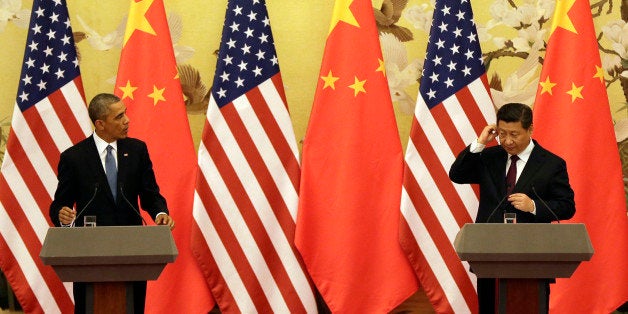
In his speech at the November 10, 2014 Asia-Pacific leaders summit, President Obama stated his intention to take relations with China to a "new level" and highlighted the importance of forging a durable strategic partnership with China to ensure its rising power does not destabilize the international system. Obama's speech was swiftly followed by what he described as a "milestone" carbon emissions deal between the U.S. and China. Despite this success, North Korea's alleged cyber-hacking and China's energy deal with Russia exacerbated tensions between the U.S. and China heading into 2015.
While economic interdependence has typically dominated the discourse around the future of relations between both great powers, recent developments indicate that the security dimension could define the U.S.-China bilateral relationship in 2015. The burgeoning security dilemma in the South Pacific triggered by rapid escalations in Chinese military spending, poses a significant challenge to American hegemony. The tendency of U.S. policymakers to vacillate between triumphalism and paranoia, in their handling of a newly assertive China, has inadvertently increased the risk of open conflict in the Asia-Pacific region.
Evaluating the Threat Posed by Chinese Military Spending
China's meteoric increases in defense spending continued in 2014, prompting a Pentagon report in June that claimed that the actual Chinese military budget exceeded $145 billion, a total far higher than official government statistics. The breakneck pace of China's development of unmanned drones caused particular alarm in the Pentagon's assessment. These concerns were given more credence by China's unveiling of an extremely precise laser weapon system that can shoot down light drones in low-altitude urban areas within five seconds of detection.
China's military buildup has alarmed the United States and caused China's main competitors in the Pacific (Japan, Vietnam and South Korea) to reciprocally bolster their military budgets. Much attention has also been drawn to the continued unwillingness of the Chinese government to acquiesce to U.S. demands for increased military budget transparency and the fact that Chinese defense spending has outstripped GDP growth. China's claims that inconsistencies in estimates of the size of its military budget can be explained by different categorization criteria for civilian and military spending have done little to assuage fears that China's "peaceful rise" could give way to belligerence in the South Pacific.
The U.S. has responded to increases in Chinese military spending by bolstering its own outlay of resources in the Pacific and the Pivot to Asia policy targets the transfer of 60 percent of U.S. naval assets to the Asia-Pacific by 2020. On the surface, diluting Chinese leverage in the Pacific through arms buildups appears effective. However, the Obama administration's military deterrence approach and contradictory rhetoric regarding whether China is a strategic partner or imminent threat, could jeopardize prospects for military cooperation with China. Obama's critical view of Chinese nationalist assertions in the Pacific, also contrasts markedly with his August 2014 depiction of China as an international security free rider that is dependent on benefits accrued from US hegemony.
The perception that Chinese military spending poses an imminent danger to security in the Pacific region also must be called into question in light of serious doubts surrounding the true extent of China's military power and preparedness for aggression. Levels of inflation in the Chinese defense sector are higher than in the overall economy and as the Chinese military enhances its technological sophistication, it has to divert its military budget increasingly to higher wage professional officers. The effectiveness of the Chinese military has also been undermined by pervasive corruption. While Xi Jinping's recent decision to centralize anti-corruption efforts under the umbrella of the Central Military Commission (CMC) is a positive step , abuse of power allegations levied against the former Deputy Head of Logistics and CMC Vice-Chairman indicate that the CCP's anti-corruption campaign is still in the embryonic stages.
How to Prevent Conflict in the Pacific
Ambiguities surrounding China's actual military strength and intentions should cause the US to devise a long-term grand strategy for the Pacific rather than continuing the current military deterrence strategy which is more effective in combatting an imminent threat. In order to reduce the risk of open conflict in the Pacific, I propose a two-pronged strategy for U.S. policymakers to employ alongside the current approach of reciprocal military buildups. The first prong is co-optive deterrence, the use of diplomatic overtures and the enhancement of recent military cooperation efforts, to discourage Chinese aggression in the Pacific region. The recent climate change deal demonstrates the potential for China and the U.S. to unite around solving a common problem, and this spirit of cooperation must extend to the security sphere. Revitalizing the cyber-security working group, which agreed in July 2013 to the cessation of the use of malicious proxies, would represent an initial step towards durable cooperation. The success of the Gulf of Aden counter-piracy joint naval drill also provides a foundation for intelligence sharing between the US and China that could extend to counter-terrorism and peacekeeping missions.
The alleged North Korean Sony hacking incident has been generally described as a setback for policymakers attempting to improve U.S.-China relations, but Jane Perlez of the New York Times, recently argued that the idiosyncratic nature of the North Korea's hacking and nuclear tests, which most likely occurred without China's consent, could cause China to cut economic support to the North Korean regime. While the complete implosion of North Korea would be against China's strategic interests, due to the potential for a massive influx of refugees, North Korea's belligerent behavior could trigger a tacit consensus between the U.S. and China that North Korea is a threat to regional stability. Such an agreement would reduce potential for polarization between Cold War-style U.S. and Chinese alliance blocs within the Pacific and advance the interests of peace.
The second prong of my proposed strategy to ameliorate tensions in the Pacific is sharpening the "Pivot to Asia" to Southeast Asian countries directly threatened by an aggressive China like Vietnam and the Philippines. The suspension of US military assistance to Thailand following the 2014 coup has caused Thailand to pivot strongly towards China with the announcement of a $12 billion rail project and a major agricultural purchase deal, which is a blow to US leverage in the region. The United States should counter China's overtures towards Thailand by consolidating a strategic partnership with Vietnam. Vietnam's recent support for the Philippines' challenge to Chinese territorial claims in the South China Sea represents a positive step towards achieving that goal. The US should also build on and coordinate with Japan's recent initiatives to build up the maritime military capacity of ASEAN states embroiled in territorial disputes with China.
Recent events and lingering ambiguities surrounding the extent of China's military power, intentions and preparedness for conflict should implore the United States to devise a long-term strategy in the Pacific that synthesizes arms buildups with expanded economic investment and alliance consolidation. However, the continued division in U.S. policymaking circles between China hawks and China cooperators renders the development of a coherent long-term grand strategy in the Pacific unlikely in the near future.
